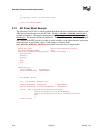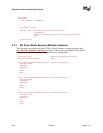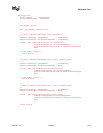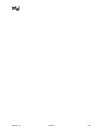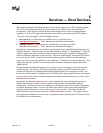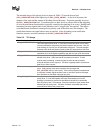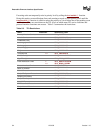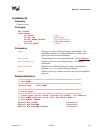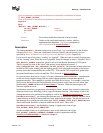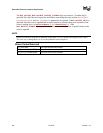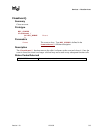
Services — Boot Services
Version 1.10 12/01/02 5-3
The intended usage of the priority levels is shown in Table 5-2 from the lowest level
(TPL_APPLICATION) to the highest level (TPL_HIGH_LEVEL). As the level increases, the
duration of the code and the amount of blocking allowed decrease. Execution generally occurs at
the TPL_APPLICATION level. Execution occurs at other levels as a direct result of the triggering
of an event notification function(this is typically caused by the signaling of an event). During timer
interrupts, firmware signals timer events when an event’s “trigger time” has expired. This allows
event notification functions to interrupt lower priority code to check devices (for example). The
notification function can signal other events as required. After all pending event notification
functions execute, execution continues at the TPL_APPLICATION level.
Table 5-2. TPL Usage
Task Priority Level Usage
TPL_APPLICATION
This is the lowest priority level. It is the level of execution which occurs when
no event notifications are pending and which interacts with the user. User I/O
(and blocking on User I/O) can be performed at this level. The boot manager
executes at this level and passes control to other EFI applications at this level.
TPL_CALLBACK Interrupts code executing below TPL_CALLBACK level. Long term
operations (such as file system operations and disk I/O) can occur at this level.
TPL_NOTIFY Interrupts code executing below TPL_NOTIFY level. Blocking is not
allowed at this level. Code executes to completion and returns. If code
requires more processing, it needs to signal an event to wait to reobtain
control at whatever level it requires. This level is typically used to process low
level IO to or from a device.
(Firmware Interrupts) This level is internal to the firmware. It is the level at which internal interrupts
occur. Code running at this level interrupts code running at the
TPL_NOTIFY level (or lower levels). If the interrupt requires extended time
to complete, firmware signals another event (or events) to perform the longer
term operations so that other interrupts can occur.
TPL_HIGH_LEVEL Interrupts code executing below TPL_HIGH_LEVEL. This is the highest
priority level. It is not interruptable (interrupts are disabled) and is used
sparingly by firmware to synchronize operations that need to be accessible
from any priority level. For example, it must be possible to signal events while
executing at any priority level. Therefore, firmware manipulates the internal
event structure while at this priority level.




